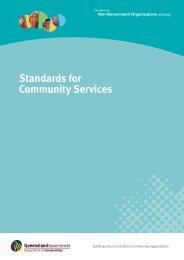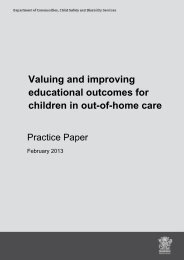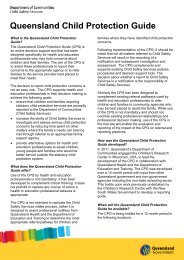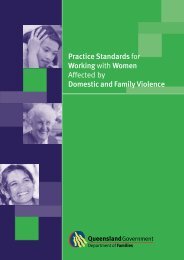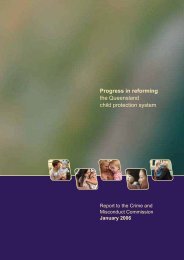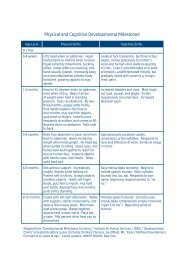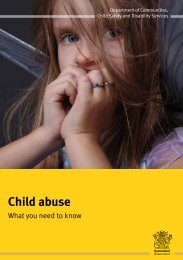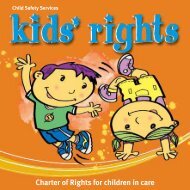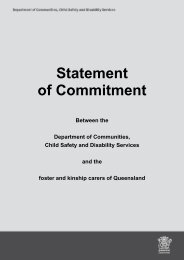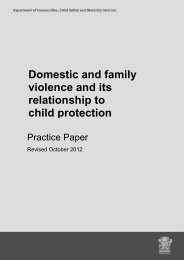Housing and Support Program (HASP): Final Evaluation Report
Housing and Support Program (HASP): Final Evaluation Report
Housing and Support Program (HASP): Final Evaluation Report
You also want an ePaper? Increase the reach of your titles
YUMPU automatically turns print PDFs into web optimized ePapers that Google loves.
5.2 Satisfaction with key life domains<br />
Much of the questionnaire data collected as part of<br />
the evaluation supports the views expressed above.<br />
Clients were asked to rate their satisfaction with a<br />
number of life domains on a seven-point scale ranging<br />
from 1 = ‘very dissatisfi ed’ to 7 = ‘very satisfi ed’ (thus<br />
a higher score represents higher levels of satisfaction).<br />
The items focused on a number of different domains,<br />
such as the way clients spend their time, their housing,<br />
mental health services they receive, the services they<br />
receive from the support agency, the neighbourhood<br />
as a place to live, personal safety, <strong>and</strong> access to<br />
transportation (see Fig. below).<br />
Fig. 5.1 Satisfaction with life domains<br />
Score<br />
7<br />
6<br />
5<br />
4<br />
3<br />
2<br />
1<br />
Spend<br />
time<br />
<strong>Housing</strong><br />
Neighbourhood<br />
<strong>Support</strong> agency<br />
Mental health<br />
service<br />
Transport<br />
Domain (1 = least satisfied to 7 = most satisfied)<br />
Personal<br />
safety<br />
The participants rated all domains as being positive,<br />
with many of the domains rated close to ‘6’ (out of a<br />
possible score of ‘7’). They were most satisfi ed by the<br />
services provided by the relevant support agency<br />
(mean score = 6.05) <strong>and</strong> least satisfi ed by the way<br />
they spent their time (mean score = 5.37).<br />
5.3 Involvement in vocational activities<br />
Clients were asked to outline their involvement<br />
in fi ve activity areas — paid employment, volunteer work,<br />
TAFE/study, Clubhouse/Rehab, <strong>and</strong> craft/leisure. Clients<br />
who claimed to have no involvement in any of these<br />
activities were classifi ed as having ‘no structured activity’<br />
(Fig. 5.2). While eight of the 80 clients interviewed (10.0%)<br />
were in paid employment, the hours worked ranged from<br />
four to 60 per week with a mean of 18.06 hours worked<br />
per week. One client had two part-time jobs that required<br />
him to work 60 hours per week. They worked in industry/<br />
factories (three), construction (two), pamphlet delivery<br />
(two), <strong>and</strong> newspaper delivery (one).<br />
In addition to paid employment, 13 (16.2%) clients<br />
indicated that they participated in volunteer work<br />
(such as bookshop, garden centre, shop assistant,<br />
sorting clothes with St Vincent de Paul, etc). The mean<br />
number of hours spent on volunteer work was 8.15 hours<br />
(range= two to 24 hours). <strong>Final</strong>ly, eight clients (10%)<br />
indicated that they attended TAFE <strong>and</strong> other training<br />
programs. On average, clients spent 7.81 hours per week<br />
in education (range = one to 28 hours).<br />
Fig. 5.2 Main activity of <strong>HASP</strong> clients<br />
Percent<br />
60<br />
40<br />
20<br />
0<br />
Paid<br />
employ<br />
Legend Current<br />
situation<br />
Volunteer TAFE/<br />
Training<br />
Clubhouse/<br />
Rehab<br />
Desire<br />
for future<br />
Craft/<br />
Leisure<br />
No<br />
structured<br />
activity<br />
<strong>Housing</strong> <strong>and</strong> <strong>Support</strong> <strong>Program</strong> (<strong>HASP</strong>)<br />
49



